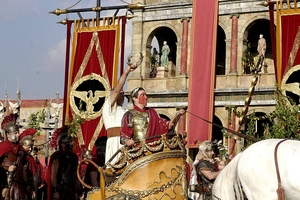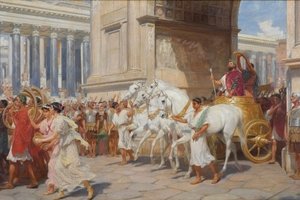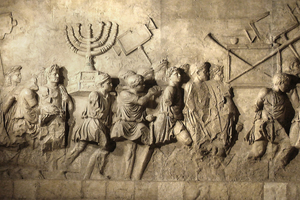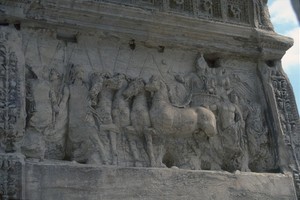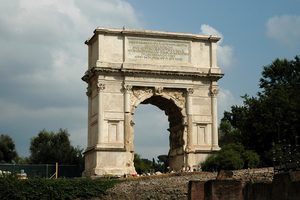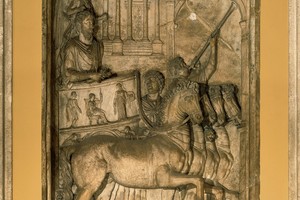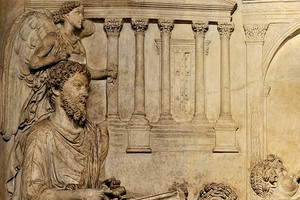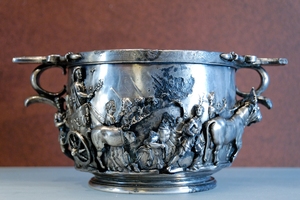Triumph
The Roman triumph (triumphus in Latin) was a ceremonial return of a general and his army to Rome after a victorious campaign. Initially, the triumph was simply the arrival of a victorious army in the capital, but over time, it evolved into a grand celebration of the general, known as the triumphator, who was honored as a deity. The triumph became a true festival for the people of Rome, often lasting several days.
The origins of the triumph can be traced back to the Etruscans, a people who lived on the Italian peninsula and later were conquered by the Romans. The Romans borrowed many elements from the peoples they conquered, including the arch, gladiatorial combat, and the triumph itself. However, the Romans adapted these elements to fit their own realities and worldview. The word TRIUMPH has Etruscan origins, and the Etruscans borrowed it from the Greek word “θρίαμβος,” which means a hymn of praise in honor of the god Dionysus. During their triumphs, the Romans would shout "io triumphe" (meaning "I triumph").
Initially, the Roman triumph was simply the return of a victorious army led by its general, the first event of which was the sacrifice to the chief god of the city. A notable feature of this event was the display of captives and spoils of war. This is the essence of the triumph. The triumph occurred after every major campaign as a matter of course. Once the ceremony was developed, it became tradition to limit its observance to special occasions, requiring approval from the Senate.
The triumph had two aspects: religious and military.
In the religious aspect, before setting out for the theater of war, the general had to perform auspices (divinations based on the flight of birds, the cries of animals, and other divine omens) and make vows for success in war. If the campaign was successful and the Senate granted a triumph, it took the form of a procession to the Capitol, where vows were fulfilled and sacrifices made to the god Jupiter. This religious aspect of the triumph was highlighted by the fact that the general appeared in the procession in the guise of a god. His clothing was similar to that of a deity and was taken from a temple specifically for the occasion. Later, emperors could own such garments as their own. The golden crown and scepter with an eagle, the general’s red-painted body (at least in early times), and the white chariot horses, which were often used by emperors, all evoked the image of Jupiter and the Sun.
No less important was the military aspect of the Roman triumph. The triumph was the final military event performed by the general during his command. It was crucial that during the triumph, the general held full military imperium and was the supreme commander in the war. This could be a consul, praetor, or dictator (a special magistrate in times of crisis). During the Empire, only the emperor could be a triumphator, as he was the supreme commander.
After a significant victory, the army would proclaim its general imperator. He would receive the fasces (bundles of rods tied together with an axe in the middle) and a laurel-wreathed report of victory. Upon returning with the army to the vicinity of Rome, the next step was to obtain Senate approval, but this could only be granted under certain conditions:
1. The future triumphator had to be proclaimed imperator by the army.
2. The victory had to be won in a just war against the state's enemies, not in a civil war or a slave revolt.
3. The victory had to be achieved in a major battle, with at least 5,000 enemy casualties in a single engagement (in the 1st century BC, generals were required to swear under oath the accuracy of their reports, with penalties for falsification). Although there are many examples of triumphs being granted for overall results, the victory had to be achieved with minimal Roman casualties.
4. The war had to be concluded so that the army could be recalled, as the presence of the victorious troops was part of the ceremony. However, over time, the need for standing armies far from Italy led to the relaxation of this rule. Also, a major victory in a large-scale or prolonged war could be rewarded with a triumph.
5. Senate approval was required. The Senate would convene outside the city walls in the Temple of Bellona (the goddess of war, who was part of Mars's retinue) or Apollo to discuss whether to grant the triumph. This was done so that the general could personally argue for his claim to a triumph. If the Senate denied the triumph, it might offer an ovation (a lesser triumph, where a sheep was sacrificed instead of a bull), but the general could appeal to the People’s Assembly.
Procession: The triumph began at the Field of Mars (outside Rome's walls) and ended with a sacrifice at the Temple of Jupiter on the Capitoline Hill.
1. Magistrates and the Senate
2. Trumpeters
3. Tangible spoils of victory: captured weapons, artistic and material treasures (statues, vases, gold), plaques with the names of conquered cities, golden crowns given to the general by cities of the conquered provinces, and wild animals.
4. A white bull for sacrifice with gilded horns, accompanied by priests.
5. Important prisoners in chains (Jugurtha, Vercingetorix, and images of the deceased Cleopatra). They were usually executed in the prison near the Capitol.
6. Lictors with fasces adorned with laurels.
7. Dancers
8. The general—triumphator in a chariot drawn by four horses (sometimes deer or elephants). The chariot and horses were decorated with laurels. The triumphator wore a purple tunic embroidered with a golden palm branch and a toga also embroidered with gold. He had a golden laurel wreath on his head, and behind him stood a slave holding a golden crown in the shape of an oak wreath, whispering "momento mori"—"remember that you are mortal." During the Empire, a slave could not stand behind the emperor, and reliefs began depicting the goddess Victory. The triumphator held a laurel branch in his right hand and an ivory scepter topped with an eagle in his left. Incense was burned before the triumphator’s chariot. His minor children, boys and girls, could ride beside him or on horseback behind. The adult children of the triumphator rode horses behind the chariot.
9. Sometimes, behind the triumphator and his children, Roman citizens who had been freed from slavery by the triumphator’s victory followed.
10. The procession ended with the infantry, shouting IO triumphe and sometimes singing bawdy songs and ditties about the triumphator, which was allowed.
The triumph could last for several days, ending with a sacrifice and banquet with senators in the Temple of Jupiter on the Capitoline Hill. Celebrations were also arranged for the soldiers in the Temple of Hercules.
The honors for the triumphator did not end there; he had the legal right to:
1. Wear the triumphal attire on festival days in the future.
2. Receive land for a house at the state’s expense and decorate the house with trophies.
3. Erect a statue as a victor among the statues of other triumphators.
4. Be buried within the city walls and have his tomb inscription indicate that he had been awarded a triumph.
5. Build triumphal arches in honor of his victories.
Related Topics
Senate, Roman Republic, Etruscans, Emperors of Rome, Roman Empire
Literature
1. Kovalev S.I., History of Rome. New edition, revised and expanded/Edited by Prof. E.D. Frolov. SPb.: Polygon, 2002.—864 p.
2. Mashkin N.A., History of Ancient Rome. Moscow: Higher School, 2006. — 753 p.
3. William Smith, A Dictionary of Greek and Roman Antiquities. Vol. II (L—Z). London: John Murray, Albemarle Street, 1891.—1072 p.
